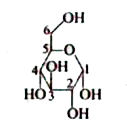The anomeric carbon in D(+) glucose is
C-1 carbon
C-2 carbon
C-5 carbon
C-6 carbon
The correct Answer is:A
To determine the anomeric carbon in D(+) glucose, we can follow these steps:
Step 1: Understand the Structure of D(+) Glucose
D(+) glucose is a six-carbon aldose sugar with the molecular formula C6H12O6. It can exist in a linear form or a cyclic form. The cyclic form is more common in solution.
Step 2: Draw the Linear Structure of D(+) Glucose
The linear structure of D(+) glucose consists of an aldehyde group at one end (C1) and hydroxyl groups (-OH) attached to the other carbon atoms (C2 to C5). The carbon atoms are numbered from C1 to C6.
Step 3: Identify the Formation of the Cyclic Structure
In solution, D(+) glucose predominantly exists in a cyclic form due to the reaction between the aldehyde group (C1) and the hydroxyl group on C5. This reaction forms a hemiacetal, resulting in a ring structure.
Step 4: Draw the Cyclic (Pyranose) Structure
The cyclic form of D(+) glucose is known as glucopyranose. It consists of five carbon atoms and one oxygen atom forming a six-membered ring. The anomeric carbon is the carbon that was originally the carbonyl carbon (C1) in the linear form.
Step 5: Identify the Anomeric Carbon
In the cyclic form, the anomeric carbon is the C1 carbon. This carbon becomes chiral upon ring formation, as it is now attached to two different groups: a hydroxyl group (-OH) and a hydrogen atom (H). The orientation of the hydroxyl group on this carbon determines whether the sugar is in the alpha (α) or beta (β) configuration.
Conclusion
The anomeric carbon in D(+) glucose is the C1 carbon.
---
D(+) glucose is a six-carbon aldose sugar with the molecular formula C6H12O6. It can exist in a linear form or a cyclic form. The cyclic form is more common in solution.
The linear structure of D(+) glucose consists of an aldehyde group at one end (C1) and hydroxyl groups (-OH) attached to the other carbon atoms (C2 to C5). The carbon atoms are numbered from C1 to C6.
In solution, D(+) glucose predominantly exists in a cyclic form due to the reaction between the aldehyde group (C1) and the hydroxyl group on C5. This reaction forms a hemiacetal, resulting in a ring structure.
The cyclic form of D(+) glucose is known as glucopyranose. It consists of five carbon atoms and one oxygen atom forming a six-membered ring. The anomeric carbon is the carbon that was originally the carbonyl carbon (C1) in the linear form.
In the cyclic form, the anomeric carbon is the C1 carbon. This carbon becomes chiral upon ring formation, as it is now attached to two different groups: a hydroxyl group (-OH) and a hydrogen atom (H). The orientation of the hydroxyl group on this carbon determines whether the sugar is in the alpha (α) or beta (β) configuration.
The anomeric carbon in D(+) glucose is the C1 carbon.
Similar Questions
Knowledge Check
In α-D-Glucose, the anomeric carbon is at :
 A1B2C4D5
A1B2C4D5
How do you explain the presence of all the six carbon atoms in glucose in a straight chain?
View SolutionThe structure of D−(+)− glucose is

The structure of L−(−)− glucose is
View SolutionWhich of the following statements about D(+) glucose is/are true?
View SolutionPolymer of α-D glucose is
View SolutionThe number of chiral centres in D-(+)-glucose is
View SolutionThe number of chiral carbon in one molecule of α-D glucose is _______ .
View SolutionPatients of diabetes have glucose in urine because
(a) Glucose is not absorbed from GF
(b) Glucose is absorbed from GF
(c) Glandular cells secreted glucose in GF
(d) Concentration of glucose is more in GF as compared to its normal amount
View Solution
